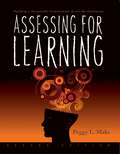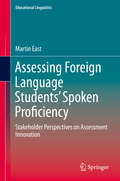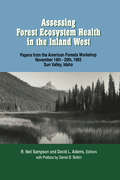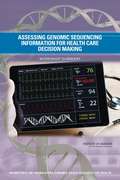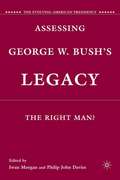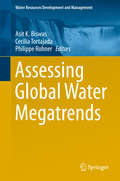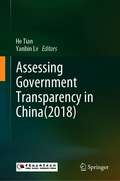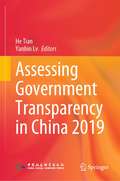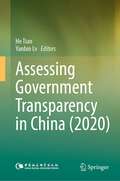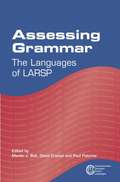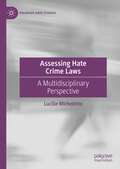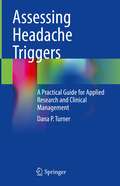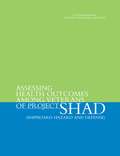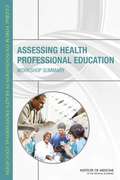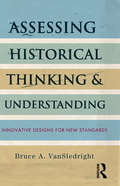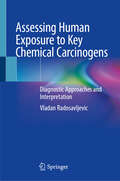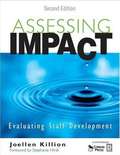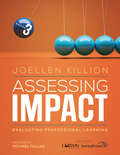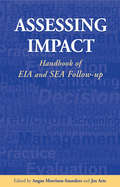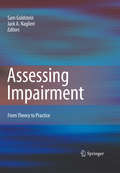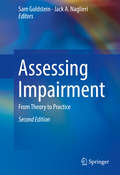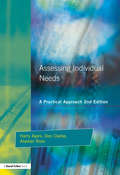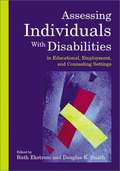- Table View
- List View
Assessing for Learning: Building a Sustainable Commitment Across the Institution
by Peggy L. MakiWhile there is consensus that institutions need to represent their educational effectiveness through documentation of student learning, the higher education community is divided between those who support national standardized tests to compare institutions’ educational effectiveness, and those who believe that valid assessment of student achievement is based on assessing the work that students produce along and at the end of their educational journeys. This book espouses the latter philosophy—what Peggy Maki sees as an integrated and authentic approach to providing evidence of student learning based on the work that students produce along the chronology of their learning. She believes that assessment needs to be humanized, as opposed to standardized, to take into account the demographics of institutions, as students do not all start at the same place in their learning. Students also need the tools to assess their own progress. In addition to updating and expanding the contents of her first edition to reflect changes in assessment practices and developments over the last seven years, such as the development of technology-enabled assessment methods and the national need for institutions to demonstrate that they are using results to improve student learning, Maki focuses on ways to deepen program and institution-level assessment within the context of collective inquiry about student learning. Recognizing that assessment is not initially a linear start-up process or even necessarily sequential, and recognizing that institutions develop processes appropriate for their mission and culture, this book does not take a prescriptive or formulaic approach to building this commitment. What it does present is a framework, with examples of processes and strategies, to assist faculty, staff, administrators, and campus leaders to develop a sustainable and shared core institutional process that deepens inquiry into what and how students learn to identify and improve patterns of weakness that inhibit learning. This book is designed to assist colleges and universities build a sustainable commitment to assessing student learning at both the institution and program levels. It provides the tools for collective inquiry among faculty, staff, administrators and students to develop evidence of students’ abilities to integrate, apply and transfer learning, as well as to construct their own meaning. Each chapter also concludes with (1) an Additional Resources section that includes references to meta-sites with further resources, so users can pursue particular issues in greater depth and detail and (2) worksheets, guides, and exercises designed to build collaborative ownership of assessment.The second edition now covers: * Strategies to connect students to an institution’s or a program’s assessment commitment* Description of the components of a comprehensive institutional commitment that engages the institution, educators, and students--all as learners* Expanded coverage of direct and indirect assessment methods, including technology-enabled methods that engage students in the process* New case studies and campus examples covering undergraduate, graduate education, and the co-curriculum* New chapter with case studies that presents a framework for a backward designed problem-based assessment process, anchored in answering open-ended research or study questions that lead to improving pedagogy and educational practices* Integration of developments across professional, scholarly, and accrediting bodies, and disciplinary organizations* Descriptions and illustrations of assessment management systems* Additional examples, exercises, guides and worksheets that align with new content
Assessing Foreign Language Students' Spoken Proficiency: Stakeholder Perspectives on Assessment Innovation (Educational Linguistics #26)
by Martin EastThis book presents an indepth study of assessment innovation and its impact on teaching and learning. The context is New Zealand, and the focus is additional languages other than English and the recent introduction of a radical new assessment of students' spoken proficiency, called interact. The book crosses the traditional theoretical and methodological boundaries associated with language testing research, which focuses on assessment performance, and presents an alternative approach where stakeholders become the centre of interest. It advances our understanding of how assessment innovation impacts on two key groups - teachers and students in schools - based on data collected from a substantial twoyear research project. It presents an account of these stakeholders' perceptions of the validity and usefulness of the new assessment in comparison with the more traditional test that it has replaced. Assessing Foreign Language Students' Spoken Proficiency makes an outstanding and original contribution to the field of second and foreign language teaching, providing a theory and research-based account of the development of a learner-centred approach to oral proficiency assessment. It is an important resource for teachers and teacher educators as well as assessment and curriculum specialists worldwide. It deserves to be widely read.
Assessing Forest Ecosystem Health in the Inland West
by David L. AdamsInland West, their historical origins, assessments of available management tools, and analyses of the various choices available to policymakers. Its goal is to help people understand the Inland West forests so that public policies can reflect a constructive and realistic framework in which forests can be managed for sustained health. This resource is the product of a scientific workshop where 35 participants, including scientists, resource managers, administrators, and environmentalists, addressed the forest health problem in the Inland West. Synthesis chapters integrate the diverse knowledge and experience which participants brought to the workshop. They identify and link together many of the ecological, social, and administrative conditions which have created the forest health problem in the West. The book is unique in that it reflects a process that fostered the use of academic research, field realities, and industrial knowledge to define an interdisciplinary problem, establish rational policy objectives, and set-up “do-able” management approaches.The following topics are analyzed: Assessing forest ecosystem health in the Inland West Historical and anticipated changes in forest ecosystems in the Inland West Defining and measuring forest health Historical range of variability as a tool for evaluating ecosystem change Administrative barriers to implementing forest health problems Economic and social dimensions of the forest health problem Fire management Ecosystem and landscape management
Assessing Genomic Sequencing Information for Health Care Decision Making: Workshop Summary
by Sarah H. BeachyRapid advances in technology have lowered the cost of sequencing an individual's genome from the several billion dollars that it cost a decade ago to just a few thousand dollars today and have correspondingly greatly expanded the use of genomic information in medicine. Because of the lack of evidence available for assessing variants, evaluation bodies have made only a few recommendations for the use of genetic tests in health care. For example, organizations, such as the Evaluation of Genomic Applications in Practice and Prevention working group, have sought to set standards for the kinds of evaluations needed to make population-level health decisions. However, due to insufficient evidence, it has been challenging to recommend the use of a genetic test. An additional challenge to using large-scale sequencing in the clinic is that it may uncover "secondary," or "incidental," findings - genetic variants that have been associated with a disease but that are not necessarily related to the conditions that led to the decision to use genomic testing. Furthermore, as more genetic variants are associated with diseases, new information becomes available about genomic tests performed previously, which raises issues about how and whether to return this information to physicians and patients and also about who is responsible for the information. To help develop a better understanding of how genomic information is used for healthcare decision making, the Roundtable on Translating Genomic-Based Research for Health of the Institute of Medicine held a workshop in Washington, DC in February 2014. Stakeholders, including clinicians, researchers, patients, and government officials, discussed the issues related to the use of genomic information in medical practice. "Assessing Genomic Sequencing Information for Health Care Decision Making" is the summary of that workshop. This report compares and contrasts evidence evaluation processes for different clinical indications and discusses key challenges in the evidence evaluation process.
Assessing George W. Bush’s Legacy
by Iwan Morgan Philip John DaviesThis book examines the legacy of the Bush presidency in term of presidential leadership, politics, and public policy. It focuses on Bush's expansion of presidential power in pursuit of the 'war on terror,' the ideological and pragmatic foundations of presidential politics, and the complexity of Bush's domestic and foreign policy legacies.
Assessing Global Water Megatrends (Water Resources Development and Management)
by Asit K. Biswas Cecilia Tortajada Philippe RohnerThis book highlights what are likely to be the future megatrends in the water sector and why and how they should be incorporated to improve water governance in the coming decades. In this first ever book on megatrends for the water sector, 22 leading world experts from different disciplines representing academia, business, government, national and international organisations discuss what the major megatrends of the future are and how they will radically change water governance in the coming decades.
Assessing Government Transparency in China(2018)
by He Tian Yanbin LvThis book, based on empirical and quantitative research, assesses the development of openness in government affairs in China. The content is divided into five parts, namely a general report, special reports, assessment reports on government transparency, reports on the openness of government in specific fields and how openness in government affairs is locally practiced.Covering the country as a whole, the general report summarizes significant aspects of openness in government affairs at all levels regarding, e.g. decision-making, law enforcement, management, service, policy interpretation and responding to public concerns. In addition, the general report reveals some current problems and provides an outline of openness in government affairs for the future. Focusing on decision-making, social assistance, environmental protection, transport, education and other fields closely related to public interest and social attention, the book subsequently summarizes a number of special works concerning openness in government affairs. Furthermore, it conducts a special study on the standardized work of openness in government affairs, which has been actively pursued by departments of the State Council and local governments.In order to provide representative coverage on openness in government affairs, the book combines innovative measures, experiences and problems, while also sharing an in-depth analysis of the difficulties involved in openness for local governments, including examples from several provinces and cities.
Assessing Government Transparency in China 2019
by He Tian Yanbin LvThis book reviews and analyzes the innovative measures introduced, lessons learned and problems encountered by selected and representative provinces, cities and counties with regard to the openness of local government affairs. To do so, it focuses on fields that are closely related to economic and social development and to the vital interests of the people, and which have thus aroused great social concerns, such as the pre-disclosure of major decision-making, policy interpretation, optimization of the business environment, and education. In turn, the book addresses standardization concerning the openness of government affairs; in this regard, numerous departments under the State Council and local governments at various levels have already engaged in pilot work, so as to provide a basis for pursuing the openness of government affairs throughout the country. The book subsequently analyzes current problems in this regard, considers the future prospects, and puts forward suitable solutions.
Assessing Government Transparency in China (2020)
by He Tian Yanbin LvThis book is the result of an objective analysis based on quantitative research of the situation of openness of government affairs in China in 2019. It consists of five parts: General Re-port, Systematic Advancement of Openness of Government Affairs, Systems Relating to Openness of Government Affairs, Openness of Government Affairs in Specific Fields and Giving Full Play to the Role of Openness of Government Affairs.This book contains a large amount of the latest and most authoritative data collected by the author's team with high credibility. The rule of law index research framework used in this book was initiated by the author's team and has been continuously updated and improved. Through the evaluation of government transparency, it demonstrates the improvement of China's open government system and the steady progress of open decision-making, as well as the significant progress of open government services. It also provides scientific and objective feasibility advice and suggestions for enhancing the awareness of openness, accurately identifying public information needs, integrating openness into the whole process of government activities, and improving the level of information security.
Assessing Government Transparency in China (2021)
by He Tian Yanbin LvThe book continues to use quantitative and empirical research methods to summarize and analyze the achievements of government openness in China in 2020. It points out that in 2020, the exploration of standardization and standardization of government affairs openness is accelerating, decision-making openness is making steady progress, and government affairs services, administrative law enforcement, and management results are all making significant progress. However, in the future, it is still necessary to further enhance the awareness of openness, identify the needs of the public, integrate openness into the whole process of government affairs activities, and improve the level of information security. Besides, the book for the first time first carries out a third-party assessment of the government affairs publicity in the national free trade zones and free trade zones, and releases research reports on the publicity of administrative punishment information, government news release,work and production resumption information, and health science popularization information.
Assessing Grammar
by David Crystal Martin J. BallThis collection brings together versions of the Language Assessment Remediation and Screening Procedure (LARSP) in thirteen different languages from around the world. It will be an invaluable resource for speechlanguage pathologists in many different countries, and for those wishing to analyse the grammatical abilities of clients of many linguistic backgrounds.
Assessing Hate Crime Laws: A Multidisciplinary Perspective (Palgrave Hate Studies)
by Lucille MichelettoThis book offers a critical analysis of hate crime law using Italy as a case study. Employing a multidisciplinary approach, it develops an international framework for mapping hate crime laws onto the phenomenon of hate crime itself, allowing for better legislation to be drafted. It shows how this analytical tool may be used in practice by applying it to legislation in Italy, where Parliament recently dismissed a legislative proposal to extend hate crime law to sex, gender, sexual orientation, gender identity, and disability. The framework allows readers to critique the rationale behind hate crime laws and the effect of, or potential effect of, their implementation. This book ultimately seeks to answer to the question of how and whether States can legitimately introduce a harsher sentence for bias motivated crimes. It bridges interdisciplinary hate studies and more traditional legal analysis. It speaks to an international audience as well as to an audience with a specific interest in the Italian context.
Assessing Headache Triggers: A Practical Guide for Applied Research and Clinical Management
by Dana P. TurnerThis book synthesizes the current research on headache triggers and details how improving the measurement properties of trigger assessments can benefit clinical and research efforts. The book begins with a detailed exploration of the history of triggers and their use in attempts to assign causes to headache attacks. Subsequent chapters then expound on the existing schools of thought on headache triggers with discussions of understudied influences on the causal assignment process, such as the role of individual trigger beliefs and perceptions. After laying this groundwork, the practical application of trigger assessment is thoroughly detailed, including assessment design types and methods of analysis. Chapters then outline the applications of trigger assessment in research and clinical practice. To conclude, the book relays descriptions of future directions and evolving theories in the area.Concise and comprehensive, Assessing Headache Triggers is an invaluable resource for clinicians who treat patients and investigators who aim to improve the lives of individuals with headache through their research.
Assessing Health Outcomes Among Veterans of Project SHAD (Shipboard Hazard and Defense)
by National Academies of Sciences Engineering MedicineBetween 1963 and 1969, the U.S. military carried out a series of tests, termed Project SHAD (Shipboard Hazard and Defense), to evaluate the vulnerabilities of U.S. Navy ships to chemical and biological warfare agents. These tests involved use of active chemical and biological agents, stimulants, tracers, and decontaminants. Approximately 5,900 military personnel, primarily from the Navy and Marine Corps, are reported to have been included in Project SHAD testing. In the 1990s some veterans who participated in the SHAD tests expressed concerns to the Department of Veterans Affairs (VA) that they were experiencing health problems that might be the result of exposures in the testing. These concerns led to a 2002 request from VA to the Institute of Medicine (IOM) to carry out an epidemiological study of the health of SHAD veterans and a comparison population of veterans who had served on similar ships or in similar units during the same time period. In response to continuing concerns, Congress in 2010 requested an additional IOM study. This second study expands on the previous IOM work by making use of additional years of follow up and some analysis of diagnostic data from Medicare and the VA health care system.
Assessing Health Professional Education: Workshop Summary
by Patricia A. Cuff"Assessing Health Professional Education" is the summary of a workshop hosted by the Institute of Medicine's Global Forum on Innovation in Health Professional Education to explore assessment of health professional education. At the event, Forum members shared personal experiences and learned from patients, students, educators, and practicing health care and prevention professionals about the role each could play in assessing the knowledge, skills, and attitudes of all learners and educators across the education to practice continuum. The workshop focused on assessing both individuals as well as team performance. This report discusses assessment challenges and opportunities for interprofessional education, team-based care, and other forms of health professional collaborations that emphasize the health and social needs of communities.
Assessing Historical Thinking and Understanding: Innovative Designs for New Standards
by Bruce A. VanSledrightAssessing Historical Thinking and Understanding advocates for a fundamental change in how educators think about making sense of learners’ developing cognition and understanding in history. Author Bruce VanSledright argues that traditional and typical standardized testing approaches are seldom up to the task of measuring the more complex understandings students are asked to attain, as they cannot fully assess what the student knows. Rather, he points forward along a path toward changes in learning, teaching, and assessing that closely aligns with the Common Core State Standards. He delves into the types of history knowledge the standards require, illustrates how they can be applied in-use in history learning contexts, and theorizes how the standards might fit together cognitively to produce deep historical understandings among students in teaching-learning contexts. By providing a variety of assessment strategies and items that align with the standards, and identifying rich, useful assessment rubrics applicable to the different types of assessments, he offers an important resource for social studies teachers and curriculum writers alike.
Assessing Human Exposure to Key Chemical Carcinogens: Diagnostic Approaches and Interpretation
by Vladan RadosavljevicThis book introduces an effective, affordable, non-invasive, and quick method to detect exposure to dangerous chemical carcinogens, which cause life-threatening conditions like cardiovascular, endocrine, neurological, hematological, dermatological, and malignant diseases. Nearly 20 million people are diagnosed with cancer annually, with almost 10 million deaths. While eliminating carcinogens completely is impossible, improving detection and monitoring—especially through specialized urine analysis—can help define preventive measures to lower carcinogen levels in the body. The chemical carcinogens discussed have been used for decades without proper evaluation of their health effects, costing millions of lives. Considering the long-term health impacts of current products is critical. Early detection is crucial as most carcinogens have cumulative effects. Identifying urinary markers of exposure can help detect, eliminate, or reduce sources of carcinogens, advancing preventive oncology. The book focuses on Group 1 chemical carcinogens classified by the International Agency for Research on Cancer (IARC). The described methods are highly effective, affordable, and applicable in any location with HPLC (High-Performance Liquid Chromatography) and ICP (Inductively Coupled Plasma) devices. They are non-invasive, requiring only urine samples, quick, and inexpensive. This volume aims to develop, improve, and implement screening methods for malignant diseases. It supports medical professionals in interpreting HPLC and ICP urinary analyses and providing guidance on reducing or avoiding carcinogen exposure. In some cases, doctors may identify sources of exposure and inform authorities to address and eliminate these hazards.
Assessing Impact: Evaluating Staff Development (Second Edition)
by Joellen KillionThis second edition of Assessing Impact: Evaluating Staff Development focuses on the importance of evaluation as a process for continuous improvement, acknowledges the policy arena that calls for more rigorous evaluation, and encourages schools and districts to adopt evaluation as a routine practice to enhance their data-driven decision-making processes.
Assessing Impact: Evaluating Professional Learning
by Joellen S. KillionDesign high-impact professional learning programs with results-based evaluations With increasing accountability pressure for evidence-based strategies and ever-tightening budgets, you want to make sure that the time, effort, and resources you are investing in your professional learning programs is truly making an impact on educator effectiveness and student achievement. In this third edition of Assessing Impact, Joellen Killion guides administrators, professional learning leaders, school improvement teams, and evaluators step by step through the rigors of producing an effective, in-depth, results-based analysis of your professional learning programs. A recognized expert in professional learning, Killion emphasizes the critical role of evaluation in bolstering effectiveness and retaining stakeholder support for ongoing educator development. The methods outlined here help you: Adhere to changes in federal and state policy relating to professional learning and educator development Facilitate the use of extensive datasets crucial for measuring feasibility, equity, sustainability, and impact of professional learning Produce more powerful, data-driven professional learning programs that benefit both students and educators Evaluate the effectiveness and impact of professional learning to make data-informed decisions and increase quality and results Assessing Impact is a vital resource for staff developers and educational leaders seeking to improve the effectiveness and sustainability of professional learning, while retaining the support of parents and the public alike. Praise for the Second Edition: "Anyone who reads this book has to feel obligated to ′set their world on fire.′ The text not only forces the reader to see how we are failing our children and their teachers, it provides the means for each of us to do better." —Michael J. Ford, Superintendent Phelps-Clifton Springs CSD, Clifton Springs, NY
Assessing Impact: Evaluating Professional Learning
by Joellen S. KillionDesign high-impact professional learning programs with results-based evaluations With increasing accountability pressure for evidence-based strategies and ever-tightening budgets, you want to make sure that the time, effort, and resources you are investing in your professional learning programs is truly making an impact on educator effectiveness and student achievement. In this third edition of Assessing Impact, Joellen Killion guides administrators, professional learning leaders, school improvement teams, and evaluators step by step through the rigors of producing an effective, in-depth, results-based analysis of your professional learning programs. A recognized expert in professional learning, Killion emphasizes the critical role of evaluation in bolstering effectiveness and retaining stakeholder support for ongoing educator development. The methods outlined here help you: Adhere to changes in federal and state policy relating to professional learning and educator development Facilitate the use of extensive datasets crucial for measuring feasibility, equity, sustainability, and impact of professional learning Produce more powerful, data-driven professional learning programs that benefit both students and educators Evaluate the effectiveness and impact of professional learning to make data-informed decisions and increase quality and results Assessing Impact is a vital resource for staff developers and educational leaders seeking to improve the effectiveness and sustainability of professional learning, while retaining the support of parents and the public alike. Praise for the Second Edition: "Anyone who reads this book has to feel obligated to ′set their world on fire.′ The text not only forces the reader to see how we are failing our children and their teachers, it provides the means for each of us to do better." —Michael J. Ford, Superintendent Phelps-Clifton Springs CSD, Clifton Springs, NY
Assessing Impact: Handbook of EIA and SEA Follow-up
by Angus Morrison-Saunders Jos ArtsWritten and edited by an authoritative team of internationally known experts in environmental impact assessment (EIA), this is the first book to present in a coherent manner the theory and practice of EIA and strategic environmental assessment (SEA) follow-up. Without some form of follow-up, the consequences of impact assessments and the environmental outcomes of development projects will remain unknown. Assessing Impact examines both EIA follow-up and the emerging practice of SEA follow-up, and showcases follow-up procedures in various countries throughout Europe, North America and Australasia. Theoretical and legislative perspectives are examined in the light of detailed case study examples, and the authors present a micro-, macro- and meta scale analysis of EIA practice ranging from individual plan and project level through to the jurisdictional level, as well as an analysis of the concept of EIA. Full coverage is given to the roles of proponents, both private and governmental, EIA regulators and the affected public in designing and executing follow-up programmes. This book is the must-have tool for impact assessment professionals, academics, regulators and proponents working on projects of all scales in all jurisdictions.
Assessing Impairment: From Theory to Practice
by Sam Goldstein Jack A. NaglieriImpairment and disability are widely used terms, yet considerable disagreement exists as to their relationship--especially when impairment means different things to different professionals in the fields of mental health, medicine, and education. Although diagnostic criteria for various disorders are clearly detailed in the DSM-IV and elsewhere, criteria for impairment remain elusive. And patients with severe limitations but minimal symptoms, or the reverse, further complicate the discussion. The first in-depth treatment of the theory, definition, and evaluation of this core concept, Assessing Impairment: From Theory to Practice cuts through the confusion and cross-talk. Leading scholars and clinicians offer a robust evidence base for a much-needed reconceptualization of impairment within the context of diagnosis and disability, arguing for a wide-ranging quality-of-life perspective. This contextual approach to assessment goes beyond mere symptom counting, resulting in more accurate diagnosis, targeted interventions, and improved patient functioning. Within this concise but comprehensive volume, coverage focuses on key areas including: Current conceptualizations from the DSM-IV and other medical models. Methodologies for measuring symptom severity and impairment. Social/behavioral issues, such as resilience, adaptive behaviors, and family environment. Developmental issues across the life span. Legal and ethical questions and civil rights issues. Impairment and disability as they relate to trauma. The interdisciplinary model proposed in Assessing Impairment gives clinicians vital tools for working with the unique limitations and strengths of every patient. Child, school, and educational psychologists will find it particularly useful, given the critical importance of early detection and the complexity of young people's lives.
Assessing Impairment: From Theory to Practice
by Sam Goldstein Jack A. NaglieriThis Second Edition of the book expands on the in-depth treatment of the theory, definition, and evaluation of impairment presented in the original volume. It explores the complex relationships between disabling conditions and impairment, with new data and insights on assessment and potential avenues for treatment. Original and revised chapters critique current models of impairment and offers an integrated model rooted in the contexts of medical, mental health, and cognitive challenges in disability. Leading scholars and clinicians provide updated evidence for a much-needed reconceptualization of impairment within the context of diagnosis and disability. This contextual approach to assessment - a wide-ranging quality-of life perspective - goes beyond symptom counting, resulting in more accurate diagnosis, targeted interventions, and improved patient functioning. Topics featured in this book include: The role of family and cross-setting supports in reducing impairment. Relationships between adaptive behavior and impairment. Legal conceptions of impairment and its implications for the assessment of psychiatric disabilities. Impairment in parenting. The Neuropsychological Impairment Scale (NIS). The Barkley Functional Impairment Scale (BFIS). The Rating Scale of Impairment (RSI). Treatment integrity in interventions for children diagnosed with DSM-5 disorders. Assessing Impairment, Second Edition, is a must-have resource for researchers, clinicians, professionals, and graduate students in clinical child, school, and developmental psychology as well as child and adolescent psychiatry, educational psychology, rehabilitation medicine/therapy, social work, and pediatrics.
Assessing Individual Needs: A Practical Approach
by Alastair Ross Harry Ayers Don ClarkeFirst Published in 1996. Routledge is an imprint of Taylor & Francis, an informa company.
Assessing Individuals with Disabilities in Educational, Employment, and Counseling Settings
by Ruth Ekstrom Douglas SmithThe book is divided into six parts. Part I covers legal, policy, and psychometric issues affecting all types of assessment. Part II covers testing accommodations, documentation, and score reporting. These two sections, as well as Part VI on additional sources of information, should be of interest to all assessment professionals. The remaining three parts focus on specific types of assessment, covering the assessment of people with disabilities in clinical and counseling settings, educational settings, and assessment for employment, certification, and licensing. (PsycINFO Database Record (c) 2004 APA, all rights reserved).
